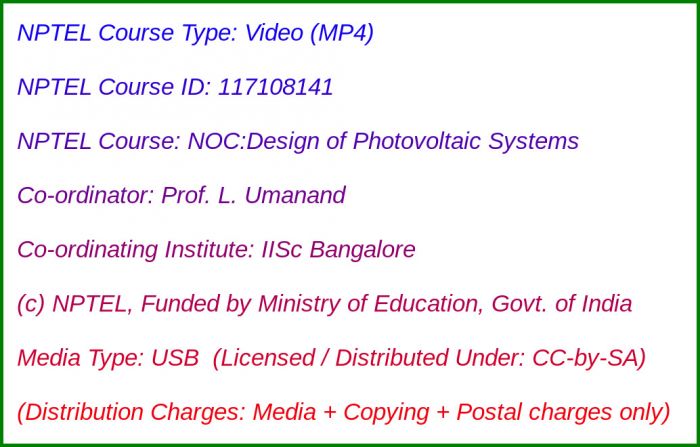
Media Storage Type : 32 GB USB Stick
NPTEL Subject Matter Expert : Prof. L. Umanand
NPTEL Co-ordinating Institute : IISc Bangalore
NPTEL Lecture Count : 118
NPTEL Course Size : 11 GB
NPTEL PDF Text Transcription : Available and Included
NPTEL Subtitle Transcription : Available and Included (SRT)
Lecture Titles:
Lecture 1 - A historical perspective
Lecture 2 - PV cell characteristics and equivalent circuit
Lecture 3 - Model of PV cell
Lecture 4 - Short Circuit, Open Circuit and peak power parameters
Lecture 5 - Datasheet study
Lecture 6 - Cell efficiency
Lecture 7 - Effect of temperature
Lecture 8 - Temperature effect calculation example
Lecture 9 - Fill factor
Lecture 10 - PV cell simulation
Lecture 11 - Identical cells in series
Lecture 12 - Load line
Lecture 13 - Non-identical cells in series
Lecture 14 - Protecting cells in series
Lecture 15 - Interconnecting modules in series
Lecture 16 - Simulation of cells in series
Lecture 17 - Identical cells in parallel
Lecture 18 - Non-identical cells in parallel
Lecture 19 - Protecting cells in parallel
Lecture 20 - Interconnecting modules
Lecture 21 - Simulation of cells in parallel
Lecture 22 - Practicals - Measuring i-v characteristics
Lecture 23 - Practicals - PV source emulation
Lecture 24 - Introduction
Lecture 25 - Insolation and irradiance
Lecture 26 - Insolation variation with time of day
Lecture 27 - Earth centric viewpoint and declination
Lecture 28 - Solar geometry
Lecture 29 - Insolation on a horizontal flat plate
Lecture 30 - Energy on a horizontal flat plate
Lecture 31 - Sunrise and sunset hour angles
Lecture 32 - Examples
Lecture 33 - Energy on a tilted flat plate
Lecture 34 - Energy plots in octave
Lecture 35 - Atmospheric effects
Lecture 36 - Airmass
Lecture 37 - Energy with atmospheric effects
Lecture 38 - Clearness index
Lecture 39 - Clearness index and energy scripts in Octave
Lecture 40 - Sizing PV for applications without batteries
Lecture 41 - Sizing PV Examples
Lecture 42 - Batteries - intro
Lecture 43 - Batteries - Capacity
Lecture 44 - Batteries - C-rate
Lecture 45 - Batteries - Efficiency
Lecture 46 - Batteries - Energy and power densities
Lecture 47 - Batteries - Comparison
Lecture 48 - Battery selection
Lecture 49 - Other energy storage methods
Lecture 50 - PV system design - Load profile
Lecture 51 - PV system design - Days of autonomy and recharge
Lecture 52 - PV system design - Battery size
Lecture 53 - PV system design - PV array size
Lecture 54 - Design toolbox in octave
Lecture 55 - MPPT concept>
Lecture 56 - Input impedance of DC-DC converters - Boost converter
Lecture 57 - Input impedance of DC-DC converters - Buck converter
Lecture 58 - Input impedance of DC-DC converters - Buck-Boost converter
Lecture 59 - Input impedance of DC-DC converters - PV module in SPICE
Lecture 60 - Input impedance of DC-DC converters -Simulation - PV and DC-DC interface
Lecture 61 - Impedance control methods
Lecture 62 - Impedance control methods- Reference cell - voltage scaling
Lecture 63 - Impedance control methods- Reference cell - current scaling
Lecture 64 - Impedance control methods- Reference cell - Sampling method
Lecture 65 - Impedance control methods- Reference cell - Power slope method 1
Lecture 66 - Impedance control methods- Reference cell - Power slope method 2
Lecture 67 - Impedance control methods- Reference cell - Hill climbing method
Lecture 68 - Practical points - Housekeeping power supply
Lecture 69 - Practical points - Gate driver
Lecture 70 - Practical points - MPPT for non-resistive loads
Lecture 71 - Simulation - MPPT
Lecture 72 - Direct PV-battery connection
Lecture 73 - Charge controller
Lecture 74 - Battery charger - Understanding current control
Lecture 75 - Battery charger - slope compensation
Lecture 76 - Battery charger - simulation of current control
Lecture 77 - Batteries in series - charge equalisation
Lecture 78 - Batteries in parallel
Lecture 79 - Peltier device - principle
Lecture 80 - Peltier element - datasheet
Lecture 81 - Peltier cooling
Lecture 82 - Thermal aspects
Lecture 83 - Thermal aspects - Conduction
Lecture 84 - Thermal aspects - Convection
Lecture 85 - Thermal aspects - A peltier refrigeration example
Lecture 86 - Thermal aspects - Radiation and mass transport
Lecture 87 - Demo of Peltier cooling
Lecture 88 - Water pumping principle
Lecture 89 - Hydraulic energy and power
Lecture 90 - Total dynamic head
Lecture 91 - Numerical solution - Colebrook formula
Lecture 92 - Octave script for head calculation
Lecture 93 - PV and Water Pumping Examples
Lecture 94 - Octave script for hydraulic power
Lecture 95 - Centrifugal pump
Lecture 96 - Reciprocating pump
Lecture 97 - PV power
Lecture 98 - Pumped hydro application
Lecture 99 - Grid connection principle
Lecture 100 - PV to grid topologies Part-I
Lecture 101 - PV to grid topologies Part-II
Lecture 102 - PV to grid topologies Part-III
Lecture 103 - 3ph d-q controlled grid connection intro
Lecture 104 - 3ph d-q controlled grid connection dq-axis theory
Lecture 105 - 3ph d-q controlled grid connection AC to DC transformations
Lecture 106 - 3ph d-q controlled grid connection DC to AC transformations
Lecture 107 - 3ph d-q controlled grid connection Complete 3ph grid connection
Lecture 108 - 1ph d-q controlled grid connection
Lecture 109 - 3ph PV-Grid interface example
Lecture 110 - SVPWM - discrete implementation
Lecture 111 - SVPWM - analog implementation
Lecture 112 - Application of integrated magnetics
Lecture 113 - Life cycle Costing Growth models
Lecture 114 - Life cycle Costing Growth model examples
Lecture 115 - Life cycle Costing Annual payment and present worth factor
Lecture 116 - Life cycle Costing LCC with example - 1
Lecture 117 - Life cycle Costing LCC example - 2
Lecture 118 - Life cycle Costing LCC example - 3

